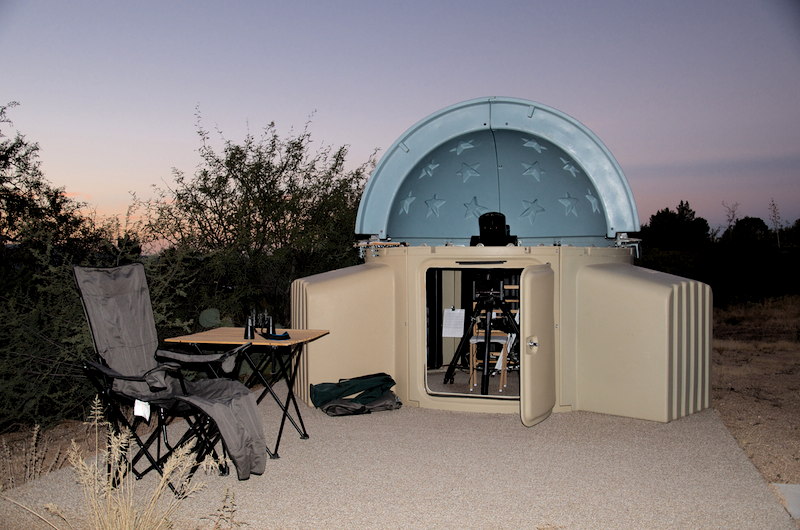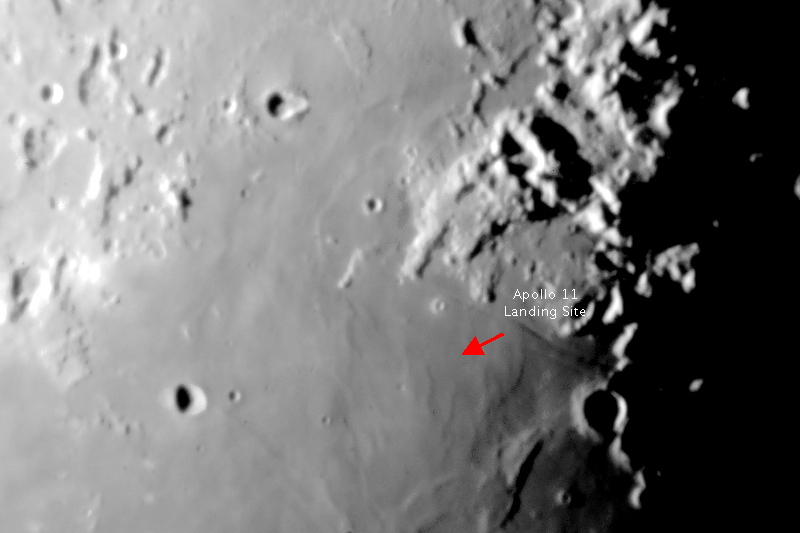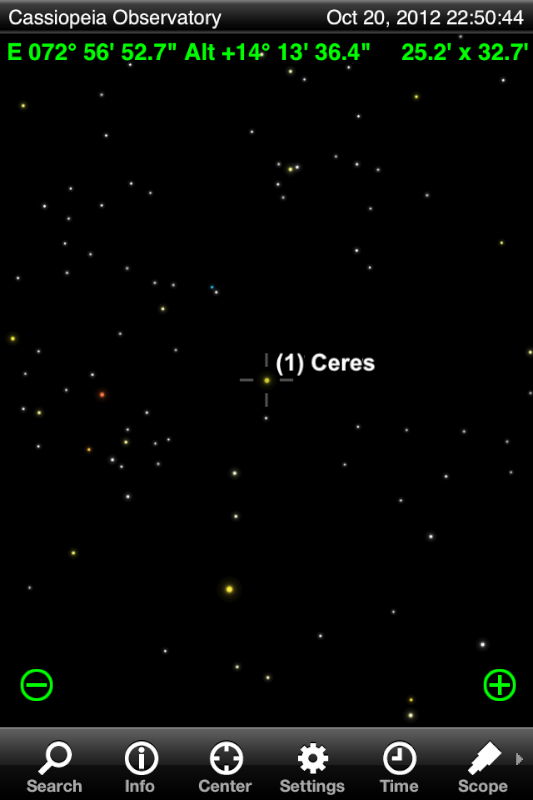
Imaging: Moon, Apollo 11 Site, NGC300 Galaxy, Asteroid Ceres
Posted: 21 October 2012
Clouds from Hurricane Paul moved in on Tuesday, 16 October. Wednesday evening, 17 October, the clouds made for a pretty sunset, with a thin crescent moon (on the left):

The 6" clip-on fan that I used in the observatory (connected to a plug-in thermostat) failed after 2.5 years of use. Have ordered a replacement.
Clouds continued until Friday, when the sky cleared. The forecast for Friday night was for clear skies, but clouds returned in the late afternoon. The observatory was finally opened Saturday, 20 October 2012, at 1744 MST, sunset, 83°F. There were some clouds low along the horizon from west to north, but the satellite image showed them as moving away. I first set up my chair and table on the observatory patio for use later for watching the Orionid Meteor Shower:

At 1800 MST, viewed Mercury at 77X, 133X, and 206X. The gibbous phase was visible at 133X and 206X. At 1803 MST, began observing the moon, 77X, 206X, and 364X. There were some great views along the terminator and in the north polar region. I switched to the visual back and mounted the iPhone 4 for afocal imaging, 77X, using the MX-1 adapter. At 1815 MST, I began lunar imaging:

I then added the 2X Barlow Lens (yielding 154X) and imaged the north polar region (cropped):

Seeing was not ideal but I took this image (cropped) of the north polar region, afocal 222X, showing some relief along the limb:

At 1833 MST, I finished iPhone imaging and switched to the diagonal for some more lunar observing. I then began tracking down the Apollo 11 landing site using Pete Lawrence's excellent How to Locate Tranquility Base on the Moon. I had planned to do this after Neil Armstrong passed away but clouds, moon phase, and travel prevented that until now. I located the position using 364X. Although seeing was still not ideal, I captured this (cropped) image using the D7000 DSLR, eyepiece projection (222X), "Hat Trick", ISO 500:

At 1920 MST, I started watching the earthlit side of the moon as several stars would be occulted over the next 1.8 hours. I used magnifications of 133X and 206X to observe 12 bright and faint stars being occulted.
While not observing occultations, I would occasionally use 7x50 binoculars for some observing. Did M31, Double Cluster, M45. I also prepared the D7000 DSLR for DSO imaging. At 2107 MST, slewed to NGC300 (faint spiral galaxy), low above the southeastern horizon from my location, which would be my DSO imaging target for the night. It was faintly visible at 77X. I mounted the D7000 DSLR at prime focus of the 8" LX200-ACF using the Off-Axis Guider and did a focus test on the star Fomalhaut using the Bahtinov Mask. Slewed back to NGC300 and began looking for a guide star. Found a good one and did a framing test exposure. Satisfied with the star and framing, I captured this guided, 5 minute, ISO 6400, slightly cropped and desaturated, image:

I removed the camera and added the visual back. At 2040 MST, viewed Jupiter and the four Galilean Moons, 77X. At 206X the view of Jupiter was excellent, with lots of details visible in the clouds. Seeing was not quite good enough for 364X.
At 2251 MST, I slewed to the asteroid Ceres and began identifying stars in the FOV using SkySafari Pro 3.6 on the iPhone:

I confirmed Ceres at 2258 MST. I attached the D7000 DSLR at prime focus, did a focus test with the Bahtinov Mask on Aldebaran. I then did a 30 second, ISO 1600, exposure at 2312 MST, 0012 MST, and 0112 MST. This is the 0112 MST exposure, cropped and rotated to match the SkySafari screen capture above:

I then began watching for Orionid meteors. I only saw 8 Orionids from 2315 MST to 0110 MST, along with 4 non-Orionid meteors.
Viewed Jupiter at 0121 MST, 77X, 133X, 206X, and 364X. Best view was still at 206X. At 0129 MST, viewed M42 and M1, 77X. Decided to end this session.
The observatory was closed at 0144 MST, 60°F. It was a good 8 hour session, even if I didn't see very many Orionid meteors.
Comments are welcome; use the Comments section below, or you can Email Me. Thanks.
Go to the previous report.
Return to the Cassiopeia Observatory Welcome Page.